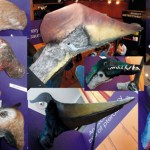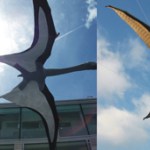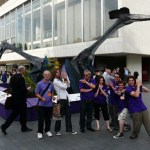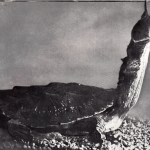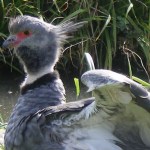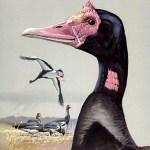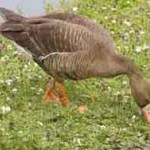
Regular readers will, hopefully, have shared my surprise on learning - firstly - that oystercatchers are sometimes 'captured' and killed by bivalves, and - secondly - that someone was clever enough to photograph such an occurrence and publish it (Baldwin 1946). Prior to seeing Baldwin's paper, I might well have imagined that such cases can occur occasionally, but I wasn't aware of anyone recording them.
Today I'm very pleased to report that I'm now aware of numerous additional such occurrences: I owe a huge debt of thanks to Tet Zoo regular Dartian, who went ferreting through the…
I said in the previous pronghorn article that the modern pronghorn - Antilocapra americana - is but the tip of the phylogenetic iceberg, if you will; the only surviving member of a group that was previously far more diverse [the adjacent photo (from wikipedia) shows Ramoceros osborni. Yes, it really looked like that, read on].
As we'll see here, fossil pronghorns encompassed a reasonable amount of diversity: there were kinds with deer-like pseudo-antlers as well as others that superficially resembled living African antelopes like kudu or nyala, there were tiny dwarf forms, and there were…
The Pronghorn or Pronghorn antelope* Antilocapra americana is a strikingly unique artiodactyl, endemic to western North America. Historically, it ranged from southern Manitoba and Washington in the north to northern Mexico in the south, and to western Iowa in the east. Between 40 and 50 million Pronghorns were alive in 1850; excessive hunting had reduced this number to 13000 by 1920. Subsequent conservation efforts have resulted in substantial recovery: there are currently between half a million and one million Pronghorns.
* Also known as the Cabrit, Prong Buck, Speedgoat (my favourite) or…
Thanks to everyone who had a go at guessing the identity of the mystery stuffed carnivoran. I am pleased, I suppose, to say that NOBODY GOT IT RIGHT, but some of you did come close.
First of all, given that I specifically referred to the animal as a carnivoran (that is, a member of the placental mammal clade Carnivora), those of you suggesting that it might be a marsupial (like a Thylacine or Tasmanian devil) should consider yourselves chastised. Also, I should note that the file name was specifically written in code and did not contain any clues to the creature's identity.
The specimen is…
Test your skills and identify this carnivoran (sorry the image isn't larger: this is all I got). It's not meant to be particularly easy, so good luck. The person who supplied the image is not allowed to play, and it would be appreciated if another individual who has used the same image on his own blog refrained from spoiling things as well :)
I'll publish the answer within the next day or so. Good luck.
I just received my copies of Dinosaurs Life Size, a children's book published by Barron's Educational in the USA and by New Burlington Books in the UK (Naish 2010). You can get it from amazon here (here from amazon.co.uk). You might wonder why I'm advertising a children's book when I could be publishing articles on gekkotans, amebelodontid proboscideans or solitaire hands (all of which are due to appear here very soon). Well, hey, it's my blog right?
Dinosaurs Life Size is large-format and includes spreads on a diversity of dinosaurs as well as pterosaurs and Mesozoic marine reptiles. Some…
A little while back we looked at the claws, bony knobs and other structures present on the hands of certain palaeognaths, waterfowl and other birds. Time to look at more of this sort of stuff - I kind of got distracted by lapwing taxonomy, so this is all going on for a bit longer than expected, sorry. Anyway...
Charadriiformes - waders, gulls and relatives - are also notable in including species that possess spurs and other peculiar forelimb structures. At least three jacanas have spurs: the Northern jacana [shown in the adjacent image, from wikipedia] is named for this feature, being known…
Inspired both by the clam catches oystercatcher story, and by Greg Laden's coverage of oystercatcher learning and predation behaviour, I thought it an opportune time to recycle the following from Tet Zoo ver 1. It originally appeared as one of my Ten Bird Meme posts of 2006...
One of my most favourite birds is the extraordinary, charismatic, beautifully interesting oystercatcher (meaing Eurasian oystercatcher Haematopus ostralegus: adjacent photo by Bjørn Christian Tørrissen, from wikipedia). One of ten or eleven extant haematopodid species, it sports pied plumage, pinkish legs, and has…
Another one from the annals of weird deaths. Believe it or don't, wading birds sometimes get their toes or bill-tips caught in bivalve shells, they remain trapped, and they then drown when the tide comes in. Here is rare photographic evidence of this behaviour...
The bird is an adult American oystercatcher Haematopus palliatus [a live one is shown below, by Bear Golden Retriever, from wikipedia*], discovered on Cape Island, South Carolina, in June 1939. William Baldwin found and photographed the specimen, and later published it in The Auk (Baldwin 1946).
The bird had obviously gotten its…
In the previous article I discussed the outside section of the Royal Society Summer Science Exhibition's pterosaur display (hosted at Royal Festival Hall on London's South Bank). The exhibition (which finished on July 4th, sorry) incorporated three flying, life-sized azhdarchids - suspended from the two adjacent building - as well as two walking ones (the latter roughly reproducing Mark's terrestrial stalking scene).
But there was much more to the exhibit than this: it also had an indoor component. The main feature was a wall covered with life-sized pterosaur heads: it looked great, sort of…
Regular readers of Tet Zoo will have seen the little clues given here and there to a big, infinitely cool project that's been months and months in the making (here's the first big hint, from August 2009). For some time now my colleagues Dave Martill, Bob Loveridge, Mark Witton and others at the University of Portsmouth have been making life-sized pterosaur models for an exhibition. As you may know by now, this exhibition was the Royal Society Summer Science Exhibition (hosted at Royal Festival Hall on the South Bank, London), and it happened between June 25th and July 4th.
Titled Pterosaurs…
Darren is away. Back soon. Here are sneak-peeks...
The amazing freaky beast that's getting all the attention, that everyone gawps at in amazement (drumroll)...
... stands at centre-left in a white shirt. Yay, it's Witton's World of Pterosaurs. Photo above stolen from Benjamin Moon.
Dave Martill hard at work.
"Hey, it's Dave Hone, of Archosaur Musings!""Hey, it's Darren Naish, of Tet Zoo!".
Much more to come very soon...
All too few people seem to realise that birds have hands*; it's just that these parts of the body are - normally - mostly obscured from view by the feathers. While the main role of the bird hand is to support remiges (the big wing feathers), less well known is that many birds possess claws, spurs, spikes and knobs on their hands and wrists that they use in offence or defence [avian hand skeletons below will be identified and discussed in part II].
* Two groups of birds atrophied and eventually lost their hands during evolution. Hesperornithines - a group of toothed, foot-propelled diving…
Good, non-technical books on anatomy are rare; good, non-technical books on avian anatomy are just about non-existent. Gary Kaiser's The Inner Bird: Anatomy and Evolution stands out as one of a kind - it is not brand-new (having been published in 2007), but still has yet to be widely recognised as the valuable piece of scholarship that it is. I will state here at the outset that I cannot recommend it highly enough.
Containing a wealth of information that ranges from the Mesozoic ancestry of birds to neornithine phylogeny, flight dynamics, functional morphology and ecology, it should be…
This could be an opportunity to say something really smart and interesting, or it could be an excuse for silliness.
I leave you, my wise readers, to decide...
UPDATE: for those struggling to interpret the sloths, the image below should help. A shot of the sloths just a few moments later is shown on the right. These are Linnaeus's two-toed sloth Choloepus didactylus: in my opinion, three-toed sloths (Bradypus) look freakier because of their short snouts.
For previous Tet Zoo pieces on sloths, see...
Ten things you didn't know about sloths
The Panamanian Blue Hill Monster (or Cerro Azul…
Over the weekend my family and I visited Amazon World Zoo Park on the Isle of Wight. I saw tons of new stuff and had a great time, but what might have been my favourite creature is one that would have been all but ignored by the vast majority of visitors. I'm talking about the Matamata Chelus fimbriatus*, a bizarre South American river turtle that is as amazing in biology and behaviour as it is in appearance. Amazon World had two of them...
* The name is sometimes written (incorrectly) as Chelus fimbriata.
Matamatas are freakishly weird: they've even been referred to as "one of the…
More waterfowl weirdness...
Most waterfowl can walk fine on land, and the majority of species are pretty agile in terms of their terrestrial abilities. But some species are so specialised for life on water, and have their legs placed so far back on their bodies, that any terrestrial abilities are poor, if not hilarious. One often reads of how divers (or loons) are only able to move on land with an awkward shuffle; less well known is that some waterfowl are pretty much the same.
One of the weirdest of waterfowl has to be the Musk duck Biziura lobata [image above from wikipedia]. This is a…
Another waterfowl fact. This one is gonna be brief. In the previous article we looked at the wing spurs of Plectropterus. They're pretty cool, but they're far from unique, and even more incredible are the much larger, dagger-like spikes seen in screamers...
Screamers (Anhimidae) are a small group (three species) of South American* waterfowl... well, they're not referred to as 'waterfowl' as often as are other members of Anseriformes, but I think they should be. One species (Horned screamer Anhima cornuta: shown in adjacent illustration) has - as you might guess - a horn! (though, technically…
Yesterday we looked briefly at goose digestion. Pretty incredible stuff, I'm sure you'll agree. Hey: wouldn't it be weird if some waterfowl were poisonous? Yeah, wouldn't it. Well... guess what?
One of the most dangerous birds in the world - I'm not kidding here - is the African spur-winged goose Plectropterus gambensis [the adjacent painting - from wikipedia - is by Louis A. Fuertes, one of the greatest zoological artists of all time]. Weighing as much as 7 kg, this formidable bird (not a goose in the strict sense, but a member of the shelduck/sheldgoose clade Tadorninae*) bears sharp…
I've just been writing about waterfowl for the day job. Which is fine, because waterfowl are among my favourite animals (as if that isn't obvious from Tet Zoo... what, you mean it isn't obvious?). Entirely because they're on my mind at the moment, here is the first of several, entirely random waterfowl facts...
Geese are consummate herbivores, and should be regarded as the avian equivalents of grazing artiodactyls and perissodactyls...
Except that they can fly. And they're much smaller. And they can't digest cellulose (by which I mean: they lack a gut flora that breaks down cellulose).…









